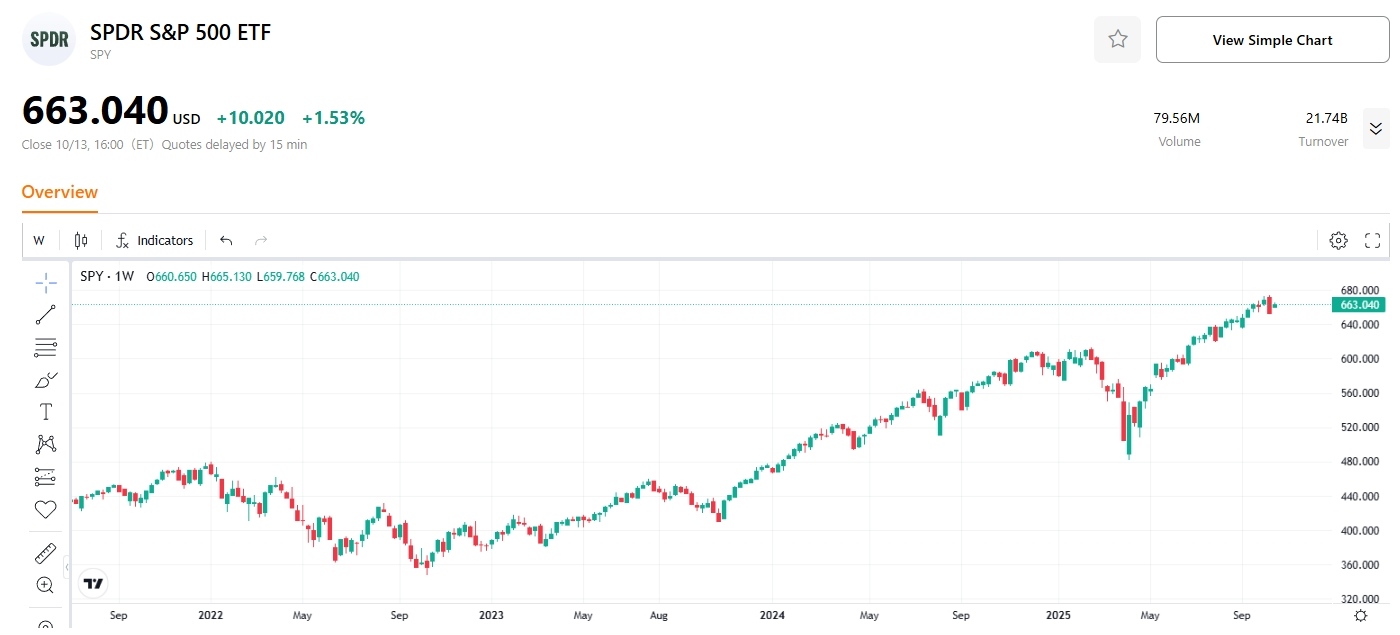“The Strongest 3-Year Bull Market Ever” — Wall Street Bets on Year Four: Don’t Fight the Fed

TradingKey - As of October 12, 2025, the AI-driven U.S. equity bull market marks its third anniversary, with the S&P 500 up 83% and nearly $28 trillion in market value added. Despite lingering concerns over AI monetization and stretched valuations, historical precedent suggests this bull run is still “young” — with room to grow.
This bull market began on October 12, 2022, fueled by the AI race, resilient U.S. economic growth, cooling inflation, and rising expectations for Federal Reserve rate cuts. Over the past three years, Wall Street has repeatedly revised forecasts upward — a sign of sustained momentum.
Although the S&P narrowly missed what would have been an 88% gain due to the sudden escalation of U.S.-China trade tensions just before the anniversary, the index has still risen 13% over the past 12 months — double the average third-year gain in prior bull markets.

SPDR S&P 500 ETF, Source: TradingKey
Historical Context: Bulls Tend to Last
Sam Stovall, Chief Investment Strategist at CFRA, noted that of the 13 bull markets since World War II, seven extended into a fourth year, with an average total gain of 88%. This current rally has already reached that level in just three years, with the S&P 500 trading at a P/E of 25 — the highest ever for a bull market’s third year.
“I’ve never seen anything like this,” Stovall said.
The Bull Is Still Young
After the strongest three-year stretch in history, investors are asking: What comes next? History suggests more upside lies ahead.
Howard Silverblatt, Senior Index Analyst at S&P Dow Jones Indices, found that the 14 bull markets since 1932 lasted an average of ~5 years, with the S&P 500 gaining over 170% on average — meaning the current tech- and mega-cap-led rally still has room to run.
CFRA data shows post-WWII bull markets lasted 4.6 years on average, with gains averaging 157%.
Carson Group stated:
“This isn't an old bull, and history says once they get to this point, they tend to last longer.”
Moreover, every recent bull market has lasted at least five years.
Jeffrey Buchbinder, LPL Financial’s Chief Equity Strategist, emphasized that economic growth is the key determinant of bull market longevity. If a recession doesn’t end it, these rallies often last five years or more.
Will Year Three Overshoot Year Four?
Chris Zand, Managing Director at Osterweis Capital Management, said clients are increasingly asking:
“How is this possible? How can we still be going up? Aren't you nervous?”
Wall Street’s concerns remain focused on:
- Pace of Fed rate cuts
- Trump policy uncertainty
- AI monetization risks
- High valuations and market concentration
Stovall warned that 2026 could be challenging due to elevated valuation multiples, trade and economic uncertainty, along with policy volatility around midterm elections.
Truist Advisory Services noted that the S&P 500 has gained over 15% in the third year — the strongest third-year performance since 1957. While Year 3 is often mixed, Year 4 tends to be strong.
But does such a powerful third year reduce fourth-year returns?
Headwinds: Expensive and Narrow
Chris Grisanti, Chief Investment Strategist at MAI Capital Management, acknowledged widespread optimism, citing solid fundamentals:
- AI’s transformative impact on profit margins and productivity
- The Fed cutting rates
- Tariff impacts less severe than feared
Yet overcoming perceptions of rich valuations and market narrowness remains a major hurdle.
According to LSEG, the S&P 500 trades at 23x forward earnings — a five-year high, well above the 10-year average of 18.7x. Any slowdown in AI capex or earnings growth could trigger a re-rating.
This rally has been led by giants like Nvidia (+1,500%) and Meta (+450%), while most other stocks lag far behind.
Today, the “Magnificent Seven” account for a record 30% of the S&P 500’s weight. Since October 2022, the equal-weight S&P 500 has underperformed the cap-weighted index by 21 percentage points — the largest gap since at least the 1990s.
Fidelity Investments called this “unusual”: in past bull markets, Fed rate cuts broadened participation. This time, the Fed’s 2022 hiking cycle worsened concentration.
Don’t Fight the Fed
A growing consensus believes the overall trend remains positive — but rotation into healthcare, small caps, and equal-weight sectors may accelerate.
Jim Paulsen, author of Paulsen Perspectives, advised:
“Don’t fight the Fed or the tape.”
Angelo Kourkafas, strategist at Edward Jones, echoed:
“There's the saying that bull markets don't die of old age, it's the Fed that kills them.”
And right now, the Fed is not planning to hike rates anytime soon — likely not for the next one to two years.







